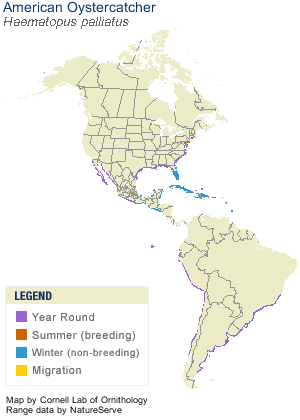Ok, really it's black and brown and red and white with slightly pinkish/pale legs.
The American Oystercatcher - it is a bold, stocky shorebird with a red beak (or red bill, if you prefer), black head and neck, dark brown back and bright white belly. You are most likely to see them along a salty coastline or marsh and... yes, they will be eating bivalves.
Map via allaboutbirds.org

After a flurry of recent posts about shorebirds, I was contacted by one of the project database gurus with some additional information - hopefully this increased awareness and ease of reporting will get more reports rolling in! Without further delay....
***
 |
| American Oystercatcher photo courtesy of Lindsay Addison |
I came across your blog while surfing, and I thought I'd write to let you know where people can submit color-banded American Oystercatcher sightings. You may already know, but there is a working group for the species which works to coordinate and facilitate rangewide research. One part of that research has been the color-banding of birds from almost all states in which they occur. Members of the public who sight a banded American Oystercatcher can report their bands at www.amoywg.org (under "Bands & Resighting -> "Report Form").
The reports will go into the working group's database of American Oystercatcher band records (captures and resightings). I curate band sightings submitted by the public, checking them for accuracy as much as possible before adding them to the working group's database, which
includes all band records from all states. If people include an email address, we write back to tell them where their bird was banded or sighted. It's easy to submit a band, and users can upload a picture as well. There will be some changes to the form, as the database is being finalized, but the website address will remain the same.
Thanks,
Lindsay
Lindsay Addison
Coastal Biologist
Audubon North Carolina
7741 Market Street, Unit D
Wilmington, NC, 28411-9444
Tel: (910) 686-7527
Fax: (910) 686-7587
laddison at audubon dot org

No comments:
Post a Comment